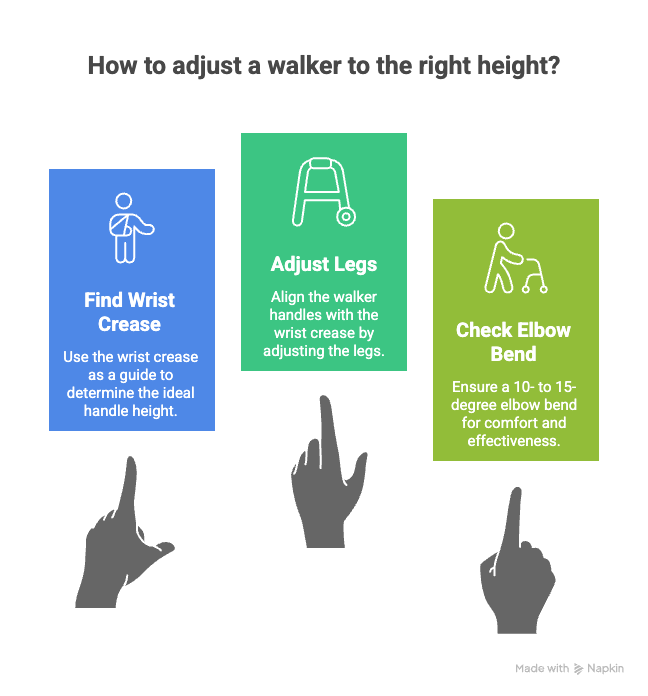Table of Contents
Adjusting the Height of Your Walker: Ensuring Comfort and Safety

Welcome to our blog post on adjusting and using a walker. As we age or face mobility challenges, walkers become vital to maintaining independence and safety. The first step in using a walker effectively is ensuring it’s adjusted to the right height. Here’s how you can do it:
- Finding the Right Height: Stand upright with your arms relaxed. Look at the crease of your wrist; this is your guide.
- Adjust the Legs: Modify all four legs of the walker so that the handles align with your wrist crease. This alignment guarantees that your walker is at the ideal height for you.
- Check Your Elbow Bend: When holding the handles, there should be a 10- to 15-degree bend in your elbows. This position is crucial for comfort and effectiveness.
Techniques for Walking with a Walker: Safe and Efficient Mobility
Now that your walker is adjusted, let’s discuss how to use it. Using the proper technique is essential for safety and to maximize the benefits of your walker.
- Step Two Technique:
- Initial Position: Push the walker out in front of you.
- Moving Forward: Step your feet between the two back legs of the walker.
- A Common Mistake: Many people walk inside the frame of the walker. This can shift your balance backward, increasing the risk of falling. Always keep the walker slightly ahead of you.
- Shopping Cart Method (For Walkers with Wheels):
- Handling the Walker: Imagine your walker is a shopping cart. Keep it a fixed distance in front of you.
- Moving Along: Gently push the walker ahead, just like you would with a shopping cart. This method is excellent for maintaining balance and reducing leg strain.
Frequently Asked Questions About Walker Adjustment and Usage
How do I know if my walker is at the correct height?
Your walker is at the correct height when the handgrips are level with your wrists when you’re standing inside the walker with your arms relaxed at your sides. Your elbows should be slightly bent (about a 15-30 degree angle) when holding the handgrips.
What’s the proper way to walk with a standard walker?
Follow these steps for proper technique:
- Lift the walker and place it a short distance in front of you
- Step forward with your weaker or injured leg first
- Then step forward with your stronger leg
- Always keep the walker stable before taking steps
How often should I check my walker for wear and tear?
You should perform a quick visual inspection before each use and a more thorough check weekly. Look for:
- Loose bolts or screws
- Worn rubber tips on the legs
- Cracks in the frame
- Sticking or malfunctioning parts
Can I use my walker on stairs?
Standard walkers are not designed for use on stairs. For navigating stairs with a walker:
- Use a handrail whenever possible
- Have someone assist you with the walker
- Consider a specialized stair-climbing walker if you regularly encounter stairs
- Always consult with your physical therapist for proper stair technique
What’s the difference between a standard walker and a rollator?
The main differences are:
- Standard walkers have no wheels and must be lifted to move, providing maximum stability
- Rollators have wheels (usually 3 or 4) and hand brakes, allowing for smoother movement but requiring more balance
- Rollators often include a seat and storage basket
- Your healthcare provider can recommend which type best suits your mobility needs
How do I properly sit down and stand up with a walker?
To sit down:
- Back up until you feel the chair against your legs
- Reach back for the armrests while holding the walker with one hand
- Lower yourself slowly into the chair
To stand up:
- Scoot to the front of the chair
- Place the walker in front of you
- Push up using the chair armrests while leaning slightly forward
- Once standing, grasp the walker handgrips
Conclusion: Embracing Your Independence
Using a walker doesn’t have to be a daunting experience. With these simple adjustments and techniques, you can use your walker effectively, ensuring comfort, safety, and maintaining your independence. Remember, the key is to adjust the walker to suit your body and to use a method that feels most comfortable for you. Happy walking!
Leave a Reply